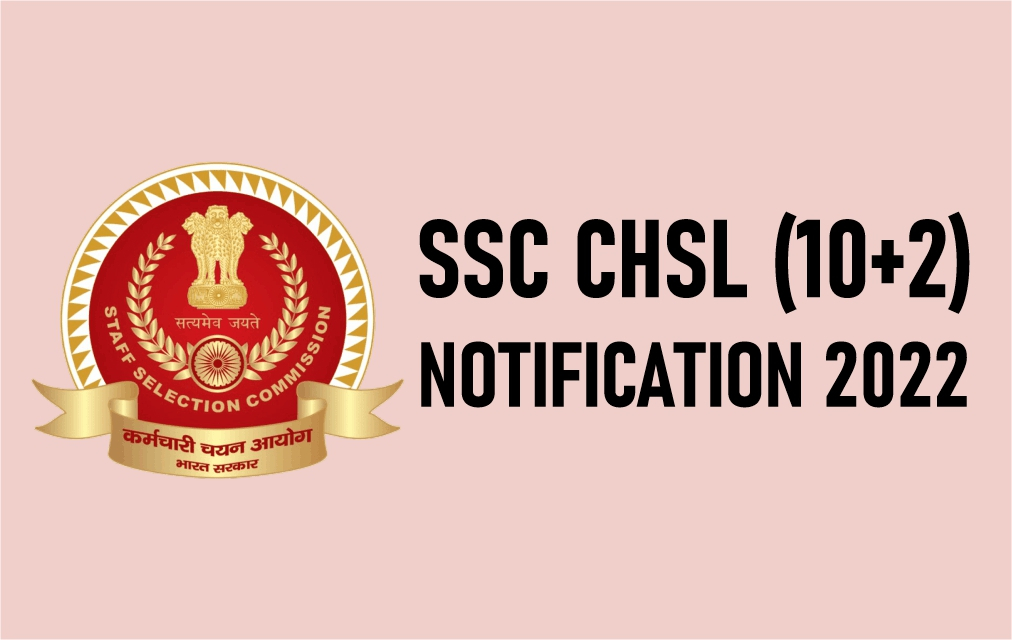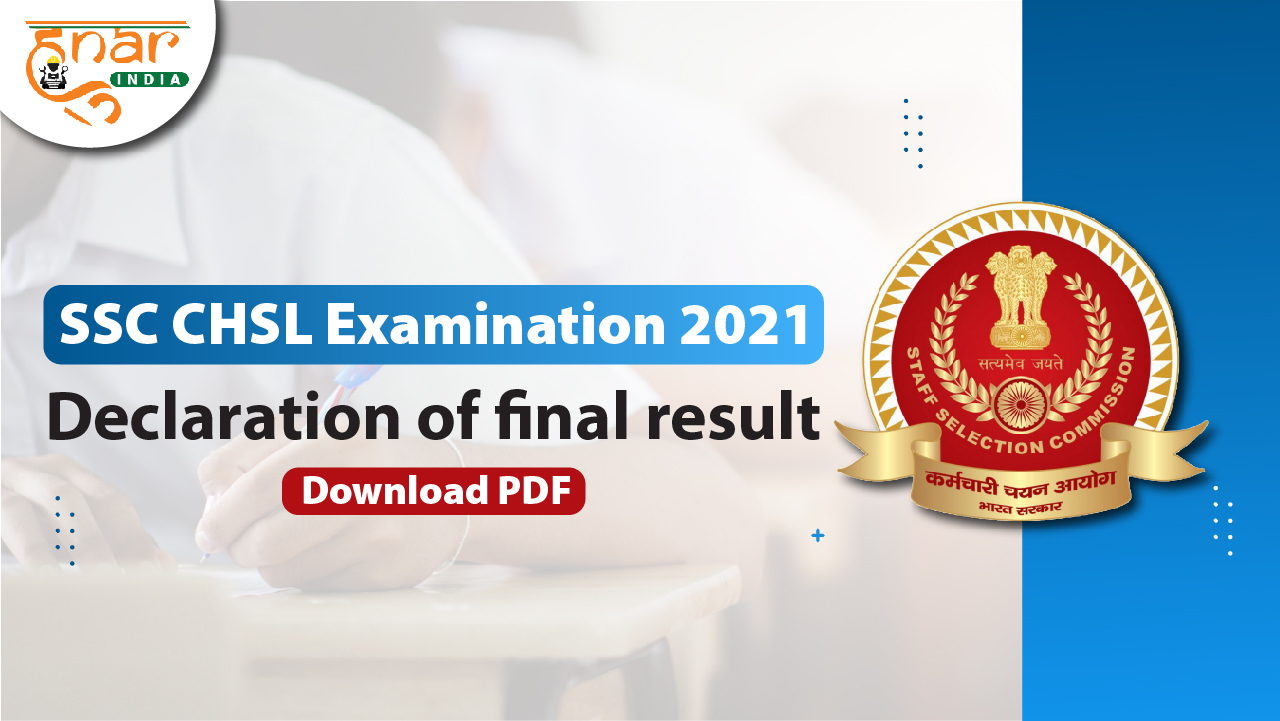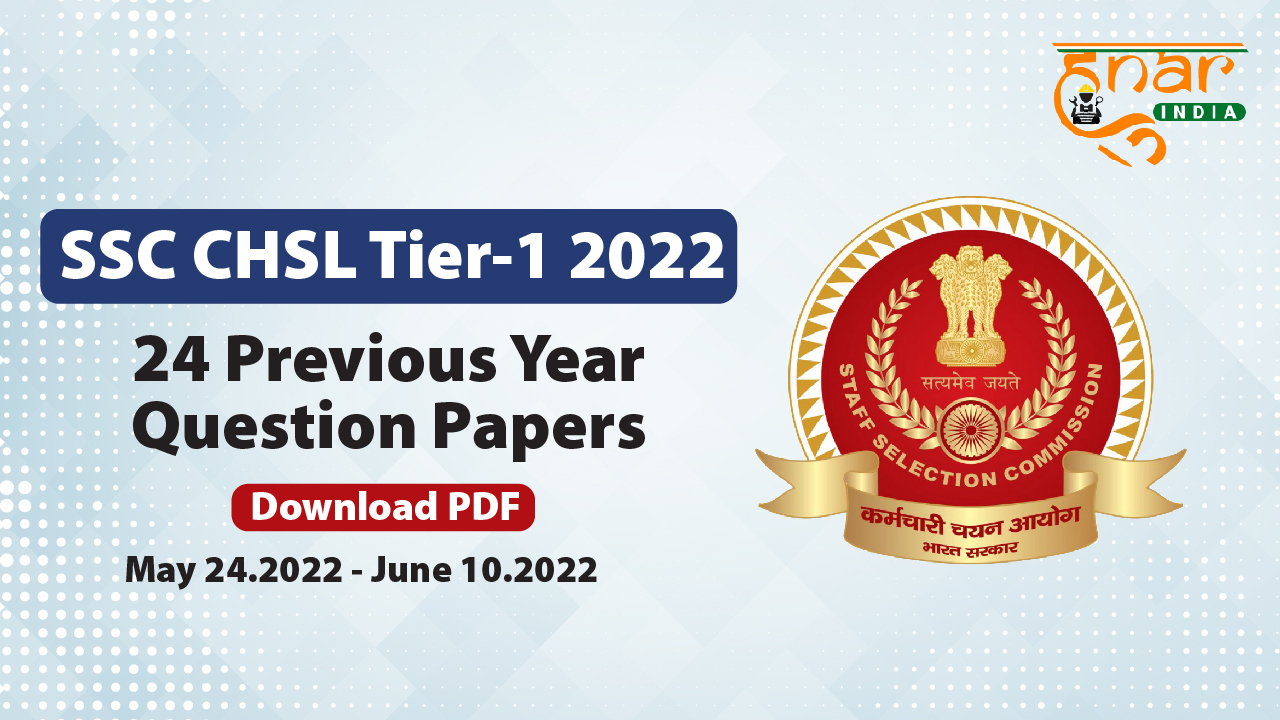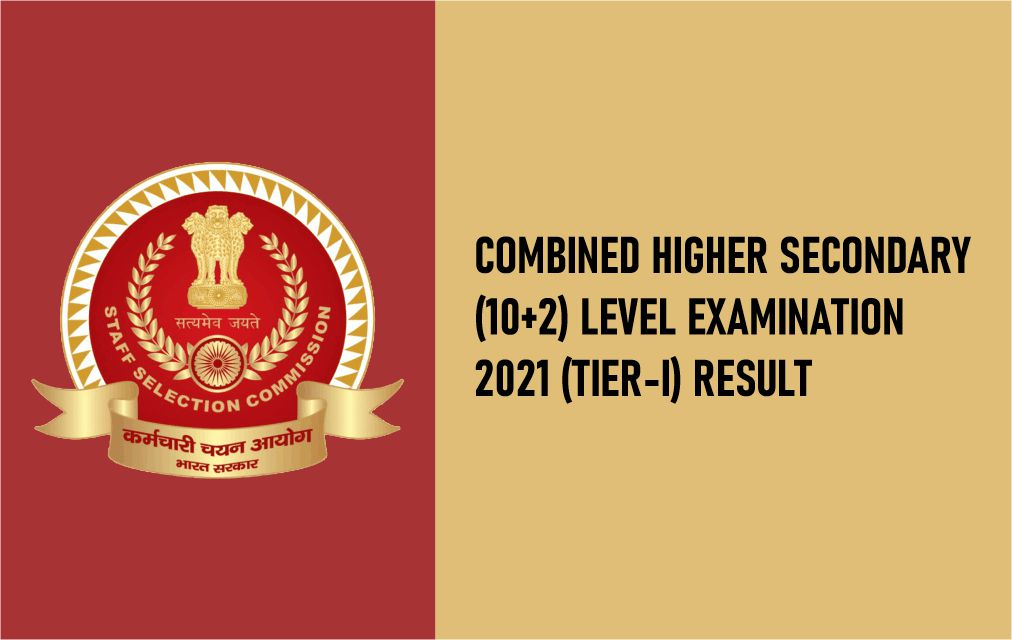Recent posts
All categories
- CBSE (4)
- JEE Main (2)
- NEET (5)
- IBPS PO/CLERK (PRE) (3)
- Bank MAINS Exams (1)
- IBPS PO/CLERK (PRE + MAINS) (3)
- SBI PO/CLERK (PRE) (4)
- Aptitude (2)
- Class 9 to 12 (1)
- Industrial Courses (1)
- Blog (169)
- Current Affair (4)
- Class 6 (1)
- IBPS RRB PO/CLERK (PRE) (1)
- IBPS RRB Office Assistant (1)
- Class 8 (1)
- Class 9 (2)
- Class 10 (3)
- Class 11 (2)
- Class 12 (3)
- IIT-JEE (2)
- SSC - CGL (11)
- SSC - CHSL (4)
- NDA (3)
- SSC - MTS (8)
- Lekhpal (2)
- NTSE SAT (1)
- KVPY (1)
- Job Oriented Courses (3)
- EDP Courses (1)
- Government Scheme (6)
- IBPS RRB PO/CLERK (PRE + MAINS) (2)
- SBI PO/CLERK (PRE + MAINS) (2)
- UPSSSC PET (2)
- NTPC CBT - 1 & 2 (1)
- SSC - GD (2)
- CDS (3)
- Gate (1)
Tags

‘4,500+ VACANCIES’ in
SSC CHSL Examination 2022
The
Staff Selection Commission will hold a competitive examination for recruitment
to the Group C posts viz. Lower Divisional Clerk/ Junior Secretariat Assistant,
and Data Entry Operators for various Ministries/ Departments/ Offices of the
Government of India and various Constitutional Bodies/ Statutory Bodies/
Tribunals, etc. The details of the examination are as follows:
Vacancies:
There
are approx. 4,500 vacancies. However, firm vacancies will be
determined in due course. Updated vacancies, if any, along with Post-wise&
category-wise vacancies will be made available on the website of the Commission
(https://ssc.nic.in> Candidate’s Corner > Tentative Vacancy) in due
course. Candidates may note that State-wise/ Zone-wise vacancies are not
collected by the Commission.
1. Scheme
of Tier-I Examination:
SSC
CHSL 2022 Tier I - Computer Based
Examination-Objective paper- Medium Hindi/English:
· Tier-I
will consist of Objective Type, Multiple choice questions.
· The
questions will be set both in English & Hindi except for English Language.
|
Tier |
Subject |
Number of Questions |
Maximum Marks |
Time Allowed |
|
I |
English Language (Basic Knowledge) |
25 |
50 |
1 hour (1 hour and 20 minutes for the candidates
eligible for scribe) |
|
General Intelligence |
25 |
50 |
||
|
Quantitative Aptitude (Basic Arithmetic Skill) |
25 |
50 |
||
|
General Awareness |
25 |
50 |
Note:
-
· There
will be a negative marking of 0.50 for each wrong answer.
2. Scheme
of Tier-II Examination:
SSC
CHSL 2022 Tier II - Computer Based Examination-Objective paper-- Medium
Hindi/English
· Tier-II
will include the following three sections having two modules each:
§ Section-I:
Ø Module-I:
Mathematical Abilities
Ø Module-II:
Reasoning and General Intelligence.
§ Section-II:
Ø Module-I:
English Language and Comprehension
Ø Module-II:
General Awareness
§ Section-III:
Ø Module-I:
Computer Knowledge Test
Ø Module-II:
Skill Test/ Typing Test
· Tier-II
will be conducted in two sessions - Session –I & Session-II, on same day.
Session-I will include conducting of Section-I, Section-II and Module-I of
Section-III. Session-II will include conducting of Module-II of Section-III.
· It
will be mandatory for the candidates to qualify all the sections of Tier-II.
· Tier-II
will consist of Objective Type, Multiple choice questions, except for Module-II
of Section-III.
· The
questions will be set in English and Hindi except for Module-II (i.e. English
Language and Comprehension module) in Section-II.
· Module-I
of Section-III i.e. Computer Knowledge Test is mandatory but qualifying in
nature.
· Module-II
of Section-III i.e. Skill Test/ Typing Test:
· Module-II
of Section-III will include conducting of Skill Test/ Typing Test in Session-II
on the same day.
· Skill
Test/ Typing Test will be of qualifying nature.
· Errors
in the Skill Test will be calculated up to 2 decimal places.
· Skill
Test/ Typing Test will be conducted as per the following scheme:
§ Skill
Test for Data Entry Operator:
Ø Skill
Test is mandatory for Data Entry Operators. No candidate is exempted from
appearing in the Skill Test.
Ø Part
A - Skill Test for the post of DEO/ DEO Grade 'A’: ‘Data
Entry Speed of 8,000 (Eight Thousand) Key Depressions per hour on Computer’ will
be adjudged on the basis of the correct entry of words/ key depressions as per
the given passage. The duration of the Test will be 15 (Fifteen) minutes and
printed matter in English containing about 2000-2200 key-depressions would be
given to each candidate who would enter the same in the Computer. The passage
to be entered in the Computer may also be displayed on the computer screen.
Ø Candidates
eligible for scribe as per Para 8.1 and 8.2 will be given Page 16 of 70
compensatory time of 5 minutes. Therefore, duration of Skill Test for such
candidates will be 20 minutes.
Ø Part
B - Typing Test for other posts i.e. LDC/ JSA: The
medium of Typing Test will be Hindi or English. The candidates will have to opt
for the medium of Typing Test (i.e. either Hindi or English) in the online
Application Form.
Ø Candidates
opting for English medium should have typing speed of 35 words per minute
(w.p.m.) and those opting for Hindi medium should have typing speed of 30 words
per minute (w.p.m.). 35 w.p.m. and 30 w.p.m. correspond to about 10500 key
depressions per hour and about 9000 key depressions per hour respectively.
Ø The
speed will be adjudged on the accuracy of typing on the Computer of a given
text passage in 10 minutes.
Ø Candidates
eligible for scribe will be given compensatory time of 5 minutes. Therefore,
duration of Typing Test for such candidates will be 15 minutes.
|
Tier |
Session |
Subject |
Number of Questions |
Maximum Marks |
Time allowed |
|
II |
Session-I (2 hours and 15
minutes) |
Section-I: Module-I: Mathematical
Abilities Module-II: Reasoning and
General Intelligence. |
30 30 Total= 60 |
60*3 = 180 |
1 hour (for each section) (1 hours and 20 minutes for the candidates
eligible for scribe) |
|
Section-II: Module-I: English
Language and Comprehension Module-II: General
Awareness |
40
20 Total = 60 |
60*3 = 180 |
|||
|
|
Section-III: Module-I: Computer
Knowledge Module |
15 |
15*3 = 45 |
15 Minutes (for each module) (20 minutes |
|
|
|
Session-II |
Section-III: Module-II: Skill
Test/ Typing Test Module |
Part A: Skill Test for
DEOs. |
- |
15 Minutes (20 minutes for the candidates
eligible for scribe) |
|
Part B: Typing Test for
LDC/ JSA. |
- |
10 Minutes (15 minutes for the candidates
eligible for scribe) |
Note:
-
· There
will be a negative marking of 1 mark for each wrong answer in Section-I,
Section II, and Module-I of Section III.
1.English Language: Spot the Error,
fill in the Blanks, Synonyms/ Homonyms, Antonyms, Spellings/ Detecting
mis-spelt words, Idioms & Phrases, one-word substitution, Improvement of
Sentences, Active/ Passive Voice of Verbs, Conversion into Direct/ Indirect
narration, Shuffling of Sentence parts, Shuffling of Sentences in a passage,
Cloze Passage, Comprehension Passage.
2. General
Intelligence: It would include questions of both verbal and
non-verbal type. The test will include questions on Semantic Analogy, Symbolic
operations, Symbolic/ Number Analogy, Trends, Figural Analogy, Space
Orientation, Semantic Classification, Venn Diagrams, Symbolic/ Number,
Classification, Drawing inferences, Figural Classification, Punched hole/
pattern-folding & unfolding, Semantic Series, Figural Pattern-folding and
completion, Number Series, Embedded figures, Figural Series, Critical Thinking,
Problem Solving, Emotional Intelligence, Word Building, Social Intelligence,
Coding and de-coding, Numerical operations.
3. Quantitative
Aptitude:
Ø Number
Systems: Computation of Whole Number, Decimal and Fractions, Relationship
between numbers.
Ø Fundamental
arithmetical operations: Percentages, Ratio and Proportion, Square roots,
Averages, Interest (Simple and Compound), Profit and Loss, Discount,
Partnership Business, Mixture and Allegation, Time and distance, Time and work.
Ø Algebra:
Basic algebraic identities of School Algebra and Elementary surds (simple
problems) and Graphs of Linear Equations.
Ø Geometry:
Familiarity with elementary geometric figures and facts: Triangle and its
various kinds of centres, Congruence and similarity of triangles, Circle and
its chords, tangents, angles subtended by chords of a circle, common tangents
to two or more circles.
ØMensuration: Triangle, Quadrilaterals,
Regular Polygons, Circle, Right Prism, Right Circular Cone, Right Circular
Cylinder, Sphere, Hemispheres, Rectangular Parallelepiped, Regular Right
Pyramid with triangular or square Base.
ØTrigonometry: Trigonometry, Trigonometric
ratios, Complementary angles, Height and distances (simple problems only)
Standard Identities like sin2𝜃 +
Cos2𝜃=1 etc.,
ØStatistical Charts: Use of Tables and
Graphs: Histogram, Frequency polygon, Bar-diagram, Pie-chart.
4.General Awareness: Questions are
designed to test the candidate’s general awareness of the environment around
him and its application to society. Questions are also designed to test
knowledge of current events and of such matters of everyday observation and
experience in their scientific aspect as may be expected of an educated person.
The test will also include questions relating to India and its neighbouring
countries especially pertaining to History, Culture, Geography, Economic Scene,
General policy and scientific research.
Indicative
Syllabus (Tier-II):
Module-I
of Session-I (Mathematical Abilities):
· Number
Systems: Computation of Whole Numbers, Decimals and
Fractions, and Relationships between numbers.
· Fundamental
arithmetical operations: Percentages, Ratio and
Proportion, Square roots, Averages, Interest (Simple and Compound), Profit and
Loss, Discount, Partnership Business, Mixture and Allegation, Time and
distance, Time and work.
· Algebra: Basic
algebraic identities of School Algebra and Elementary surds (simple problems)
and Graphs of Linear Equations.
· Geometry: Familiarity
with elementary geometric figures and facts: Triangle and its various kinds of
centers, Congruence and similarity of triangles, Circle and its chords,
tangents, angles subtended by chords of a circle, common tangents to two or
more circles.
· Mensuration: Triangle,
Quadrilaterals, Regular Polygons, Circle, Right Prism, Right Circular Cone,
Right Circular Cylinder, Sphere, Hemispheres, Rectangular Parallelepiped,
Regular Right Pyramid with triangular or square Base.
· Trigonometry: Trigonometry,
Trigonometric ratios, Complementary angles, Height and distances (simple
problems only) Standard Identities like sin2 𝜃 + Cos2 𝜃=1 etc.
· Statistics
and probability: Use of Tables and Graphs: Histogram,
Frequency polygon, Bar-diagram, Pie-chart; Measures of central tendency: mean,
median, mode, standard deviation; calculation of simple probabilities
Module-II
of Section-I (Reasoning and General Intelligence):
Questions
of both verbal and non-verbal type. These will include questions on Semantic
Analogy, Symbolic operations, Symbolic/ Number Analogy, Trends, Figural
Analogy, Space Orientation, Semantic Classification, Venn Diagrams, Symbolic/
Number Classification, Drawing inferences, Figural Classification, Punched
hole/ pattern-folding & unfolding, Semantic Series, Figural Pattern-folding
and completion, Number Series, Embedded figures, Figural Series, Critical Thinking,
Problem Solving, Emotional Intelligence, Word Building, Social Intelligence,
Coding and de-coding, Numerical operations, Other subtopics, if any.
Module-I
of Section-II (English Language and Comprehension):
Vocabulary,
grammar, sentence structure, synonyms, antonyms and their correct usage; Spot
the Error, Fill in the Blanks, Synonyms/ Homonyms, Antonyms, Spellings/
Detecting mis-spelt words, Idioms & Phrases, One word substitution,
Improvement of Sentences, Active/ Passive Voice of Verbs, Conversion into Direct/
Indirect narration, Shuffling of Sentence parts, Shuffling of Sentences in a
passage, Cloze Passage, Comprehension Passage. To test comprehension, two or
more paragraphs will be given and questions based on those will be asked. At
least one paragraph should be a simple one based on a book or a story and the
other paragraph should be based on current affairs editorial or a report.
Module-II
of Section-II (General Awareness):
Questions
are designed to test the candidates’ general awareness of the environment
around them and its application to society. Questions are also designed to test
knowledge of current events and of such matters of everyday observation and
experience in their scientific aspect as may be expected of an educated person.
The test will also include questions relating to India and its neighbouring
countries especially pertaining to History, Culture, Geography, Economic Scene,
General policy and scientific research.
Module-I
of Section-III of Paper-I (Computer Proficiency):
· Computer
Basics: Organization of a computer, Central
Processing Unit (CPU), input/ output devices, computer memory, memory
organization, back- up devices, PORTs, Windows Explorer, and Keyboard
shortcuts.
· Software: Windows
Operating system including basics of Microsoft Office like MS word, MS Excel
and PowerPoint, etc.
· Working
with the Internet and e-mails: Web Browsing
& Searching, Downloading & Uploading, Managing an E-mail Account, and
e-Banking.
· Basics
of networking and cyber security: Networking
devices and protocols, Network and information security threats (like hacking,
virus, worms, Trojan etc.) and preventive measures.
Important
Dates
The
tentative schedule of events is as follows:
|
Activity |
Dates |
|
Dates
for submission of online applications |
06-12-2022
to 04-01-2023 |
|
Last
date and time for receipt of online applications |
04-01-2023
(23:00) |
|
Last
date and time for generation of offline Challan |
04-01-2023
(23:00) |
|
Last
date and time for making online fee payment |
05-01-2023
(23:00) |
|
Last
date for payment through Challan (during working hours of Bank) |
06-01-2023 |
|
Dates
of ‘Window for Application Form Correction’ including online payment. |
09-01-2023
to 10-01-2023 (23:00) |
|
Tier-I
(Computer Based Examination) |
09.03.2023
to 21.03.2023 |
|
Tentative
Schedule of Tier-II (Computer Based Examination) |
To
be notified later |
SSC
CHSL 2022 Tier-I Examination Date
SSC
has released the dates for SSC CHSL Examination, 2022 (Tier-I) for various
regions on its official SSC websites.
SSC
CHSL Examination, 2022 (Tier-II) is scheduled from 09.03.2023 to
21.03.2023.
Note:
- The above schedule is subject to the
prevailing conditions and Government guidelines issued from time to time
regarding handling of the Covid-19 pandemic.
- The candidates are advised to visit the
website of the Commission at regular intervals for further updates.
- To download the PDF of the same, click here.
- Official website of SSC : https://ssc.nic.in/
Mode
of Selection:
1. Minimum
qualifying marks in Tier-I, Section-I, Section-II & Module-I of Section-III
of Tier-II Examination are as follows:
|
Category |
Cut-off
Marks |
|
UR |
30% |
|
OBC/
EWS |
25% |
|
Others |
20% |
2.Candidates will be shortlisted for Tier-II
Examination on the basis of their performance in Tier-I Examination.
3.Normalized scores of candidates will be used to
determine merit and for final selection.
4.There may be separate category-wise cut-offs in
Tier-I and subsequent Tiers for different posts i.e. (i) DEO/ DEO Grade 'A' and
(ii) LDC/ JSA.
5. Tier-II
Examination will be conducted for all the candidates qualified in Tier-I.
6. In
Tier-II, all the candidates will be required to appear in all three sections.
7. In
Tier-II, it will be mandatory for the candidates to qualify all the sections.
8.Based on the aggregate performance in Section-I
and Section-II of Tier-II Examination, candidates will be shortlisted for
evaluation of Section-III of Tier-II Examination.
9. The
candidates who are not qualified in Section-I + Section-II will not be eligible
for evaluation of Section-III and they will not be considered for further
selection process.
10. Section-III of Tier-II is qualifying in
nature, in other words both modules i.e. Computer Knowledge Test and Skill
Test/ Typing Test are qualifying in nature.
11. Skill
Test for DEOs is mandatory for all the qualified candidates.
12. Typing
Test for posts other than DEOs is mandatory for all candidates except those who
are exempted from appearing in the Typing Test.
13. Merit
list will be prepared on the basis of overall performance of candidates in
Tier-II Examination only. Merit List will be prepared on the basis of aggregate
marks scored in Section-I & Section-II of Tier-II examination only subject
to qualifying Section-III (both modules) of Tier-II as per the qualifying
standards fixed by the Commission.
14.Final selection of candidates, in each category,
will be made on the basis of ‘overall performance in Tier-II Examination’ and
‘preference of posts’ exercised by them. Once the candidate has been given his
first available preference, as per his merit, he will not be considered for any
other option.
15. Based
on the marks scored in Tier-I i.e. Computer Based Examination, candidates will
be shortlisted, category-wise, to appear in Tier-II Examination.
16. Separate
cut-offs will be fixed for Paper-II of Tier-II (i.e. for the post of Junior
Statistical Officer), Paper-III of Tier-II (i.e. for the posts of Assistant
Audit Officer and Assistant Accounts Officer) and for Paper-I of Tier-II (i.e.
for all other posts).
17. Tier-II
Examination will be conducted for all the candidates qualified in Tier-I. In
Tier-II, all the candidates will be required to appear in all three sections of
Paper-I. However, only those candidates shortlisted for the posts of Junior
Statistical Officer and Assistant Audit Officer/ Assistant Accounts Officer
will be required to appear in Paper-II and Paper-III respectively.
18. In
Paper-I of Tier-II, it will be mandatory for the candidates to qualify all the
sections.
19. Based on the aggregate performance in Section-I
and Section-II of Paper-I of the Tier-II Examination, candidates will be
shortlisted for evaluation of Section III of Paper-I of Tier-II Examination.
The candidates who are not qualified in Section-I + Section-II will not be
eligible for evaluation of Section-III and they will not be considered for the
further selection process.
20. Section-III
of Paper-I of Tier-II is qualifying in nature, in other words both modules i.e.
Computer Knowledge Test and DEST are qualifying in nature.
Nationality/Citizenship:
A
candidate must be either:
· a
citizen of India, or
· a
subject of Nepal, or
· a
subject of Bhutan, or
· a
Tibetan refugee who came over to India, before the 1st January, 1962 with the
intention of permanently settling in India, or
· a
person of Indian origin who has migrated from Pakistan, Burma, Sri Lanka, East
African Countries of Kenya, Uganda, the United Republic of Tanzania (Formerly
Tanganyika and Zanzibar), Zambia, Malawi, Zaire, Ethiopia and Vietnam with the
intention of permanently settling in India.
Essential
Educational Qualifications (As on 04-01-2023):
· Candidates
must have passed 12th Standard or equivalent examination from a recognized
Board or University.
· The
candidate must possess Essential Qualification on or before the cut-off date
i.e. 04-01-2023.
Age
limit (As on 01-01-2022):
· Age
limit for the posts is 18-27 years as on 01-01-2022 i.e. Candidates born not
before 02-01-1995 and not later than 01-01-2004 are eligible to apply.
· Permissible
relaxation in upper age limit for different categories are as under:
|
S. No. |
Age Limit |
Age
Relaxation |
|
1. |
SC/ST |
5 Years |
|
2. |
OBC |
3 Years |
|
3. |
Persons
with Benchmark Disability (Unreserved) |
10 Years |
|
4. |
Persons
with Benchmark Disability (OBC) |
13 Years |
|
5. |
Persons
with Benchmark Disability (SC/ST) |
15 Years |
|
6. |
Ex-Servicemen
(ESM) |
5 Years |
|
7. |
Defence
Personnel disabled in operation during hostilities with any foreign country
or in a disturbed area and released as a consequence thereof |
3 years |
|
8. |
Defence
Personnel disabled in operation during hostilities with any foreign country
or in a disturbed area and released as a consequence thereof (SC/ST) |
8 years |
|
9. |
Central
Government Civilian Employees: Who have rendered not less than 3 years
regular and continuous service as on closing date for receipt of online
applications. |
Up to 40 years of age |
|
10. |
Central
Government Civilian Employees: Who have rendered not less than 3 years
regular and continuous service as on closing date for receipt of online
applications (SC/ ST). |
Up to 45 years of age |
|
11. |
Widows/
Divorced Women/ Women judicially separated and who are not remarried. |
Up to 35 years of age |
|
12. |
Widows/
Divorced Women/ Women judicially separated and who are not remarried (SC/
ST). |
Up to 40 years of age |
Steps
to Apply
· Applications
must be submitted only in online mode at the website of SSC Headquarters i.e.
https://ssc.nic.in.
· candidates
are required to upload the scanned color passport-size photograph in JPEG
format (20 KB to 50 KB).
· Image
dimension of the photograph should be about 3.5 cm (width) x 4.5 cm (height).
· Scanned
signature in JPEG format (10 to 20 KB). Image dimension of the signature should
be about 4.0 cm (width) x 2.0 cm (height).
· Details
of qualifying educational qualification like passing year, roll number,
percentage/ CGPA, name of Board, etc are required.
· Last
date and time for submission of online applications is 04-01-2023 (23:00).
· Before
submission of the online application, candidates must check through Preview/
Print option that they have filled correct details in each field of the form.
Application
Fee:
· Fee
can be paid online through BHIM UPI, Net Banking or by using Visa, MasterCard,
Maestro, RuPay Credit or Debit cards or in cash at SBI Branches by generating
SBI Challan.
· Online
fees can be paid by candidates up to 05-01-2023 (23:00 hours). However, candidates
who wish to make a cash payment through the challan of SBI may make payment in
cash at the Branches of SBI within the working hours of bank up to 06- 01-2023
provided the challan has been generated by them before 04-01-2023 (23:00
hours).
|
Category |
Application Fee |
|
General/OBC |
₹100/- |
|
Women
(of all categories)/SC/ST/PwD and ESM |
Nil |
FAQs
Ques.
I am in the last year of college. Can I apply for the SSC CHSL exam?
Ans.
Yes, the minimum qualification required for appearing in SSC CHSL is 12th
Standard or equivalent examination from a recognized Board or University.
Ques.
Are there any percentage criteria to apply for the SSC CHSL Exam?
Ans.
There are no minimum percentage criteria to apply for the SSC CHSL exam.
Ques.
Is there any negative marking in SSC CHSL Exam?
Ans.
Yes, there will be a negative marking of 0.50 marks for each wrong answer in
Tier-I. There will be a negative marking of 1 mark for each wrong answer in
Section-I, Section-II, and Module-I of Section-III in Tier-II.
Ques.
When will the SSC CHSL admit card be released?
Ans.
Admit Cards will be released 15 days before the exam dates.
Ques.
How many times can the SSC CHSL Exam be attempted?
Ans.
There is no limit to how many times can SSC CHSL examination be attempted as
long as the eligibility criteria are fulfilled.
Ques.
What are SSC CHSL 2022 Job Profiles?
Ans.
There are various post in SSC CHSL 2022 Recruitment, i.e. Lower Divisional
Clerk/ Junior Secretariat Assistant, and Data Entry Operators for various
Ministries/ Departments/ Offices of the Government of India.
Recent posts
All categories
- CBSE (4)
- JEE Main (2)
- NEET (5)
- IBPS PO/CLERK (PRE) (3)
- Bank MAINS Exams (1)
- IBPS PO/CLERK (PRE + MAINS) (3)
- SBI PO/CLERK (PRE) (4)
- Aptitude (2)
- Class 9 to 12 (1)
- Industrial Courses (1)
- Blog (169)
- Current Affair (4)
- Class 6 (1)
- IBPS RRB PO/CLERK (PRE) (1)
- IBPS RRB Office Assistant (1)
- Class 8 (1)
- Class 9 (2)
- Class 10 (3)
- Class 11 (2)
- Class 12 (3)
- IIT-JEE (2)
- SSC - CGL (11)
- SSC - CHSL (4)
- NDA (3)
- SSC - MTS (8)
- Lekhpal (2)
- NTSE SAT (1)
- KVPY (1)
- Job Oriented Courses (3)
- EDP Courses (1)
- Government Scheme (6)
- IBPS RRB PO/CLERK (PRE + MAINS) (2)
- SBI PO/CLERK (PRE + MAINS) (2)
- UPSSSC PET (2)
- NTPC CBT - 1 & 2 (1)
- SSC - GD (2)
- CDS (3)
- Gate (1)









